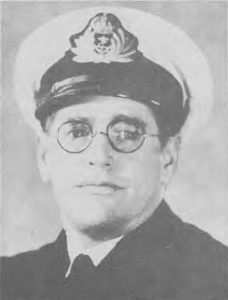- Author
- Downs, Ian G F
- Subjects
- History - general
- Tags
-
- RAN Ships
- None noted.
- Publication
- January 1972 edition of the Naval Historical Review (all rights reserved)
Allied airmen forced down by the fighting were often rescued by Coastwatchers and kept safely from searching Japanese patrols. As the tide of war turned in our favour Coastwatchers were gradually relieved or replaced in close liaison with the requirements of each operational area. Their final activity, when the Japanese were bypassed or in retreat, was to arm bands of local natives and direct them in guerrilla operations against the remnants of the enemy. The whole pattern for their operations was developed from what had been achieved on Bougainville. Coast-watchers took part in the campaigns that dislodged the Japanese from Buna, Salamaua, Lae, Finschafen, the Rai Coast, Madang, Wewak, Aitape, Vanimo and across the border into Dutch New Guinea.
It is not the purpose of this account to list names or record all the actions in which Coastwatchers and those serving other units related to them took part. The opportunity that Read and Mason created and exploited on Bougainville was an object lesson for the others and a fair example of the common difficulties that had to be overcome.
W.J. Read was the District Officer at Buka Passage when the Japanese invasion became obvious and like other government officers in situations of importance he had been selected as a Coastwatcher. He immediately realised the danger and limitations of remaining on the small island of Sohano and made preparations to move to the big island of Bougainville where he would have room to maneuver and a choice of observation points. He collected and hid stores at vantage points so that they would be ready when needed. By nature a perfectionist, he took tremendous care of his teleradio equipment, realising that he would be unable to obtain spares or get a replacement for a long time. He was a realist, and understood more clearly than most that he could not expect to enjoy forever the loyalty of the local population. The assistants and carriers he employed were mostly from amongst the ‘foreign’ natives from the New Guinea mainland and other islands who had been marooned by the invasion, which had also terminated their employment. He was careful in his selection of police who were to accompany him. Having done his utmost to secure the escape and dispersal of the civilian population and to advise those who would not leave their properties to seek the safety of the interior, Read was careful to detach himself from them as much as possible in order not to compromise his own usefulness and freedom of action as a Coastwatcher. He was not content to let the war pass him by within the relative safety of a limited contribution. He patrolled widely and made visits to Kieta which had been evacuated by his government superior. Kieta, the administrative headquarters for Bougainville was first taken over by a German and then by the very effective Japanese alien, Tashira. Read continually kept on the move in search of information of the enemy. His selection and supply of future observation points was at all times farsighted and aggressive.

Coastwatcher in South Bougainville, 1942-43
Paul Mason of Inus Plantation was a quiet man whose humble bespectacled presence gives no clue to his vigour, initiative and purposeful self-confidence. Like Jack Read, he had decided to see the war out on Bougainville and made plans to keep himself ‘in being’ as a Coastwatcher. One of his many talents was an ability to maintain and repair radio equipment and this proved of great importance to himself and to other Coastwatchers. A truly spartan man, he did not handicap himself with unnecessary comforts and as the war progressed his ability to precisely identify ships and aircraft in order to make accurate and informative reports became remarkable. After some seventeen months he was withdrawn by submarine when Japanese patrols, one hundred strong, combined in a concentration of inland searches to make the positions of both Read and Mason completely untenable. At no stage had either of them operated without extraordinary risk. Mason returned to Bougainville to take charge of guerrilla operations in 1944 which accounted for hundreds of confirmed Japanese ‘kills’ and the rescue of missionaries and others still interned.
Read and Mason suffered injury and sickness, were frequently without food and forced to live in the open when making their escape from ambush or when their camps and observation posts were betrayed by informers under the pressure of Japanese patrolling. As the war continued, Bougainville became isolated from allied success elsewhere. The Japanese defeat in the Solomons was too distant and the Bougainville people were easily convinced that the Japanese occupation would be permanent. They joined in the harassment of the Coastwatchers. Each time Read and Mason moved, they were eventually hunted down. Their teleradio equipment had to be moved, hidden and left in the jungle. Then it had to be recovered again, sometimes at great risk, and carried to a new observation point to get it back into action. Sometimes a handful of men did this with double loads in relays. They had to forage for fuel to feed their battery chargers as well as find food for themselves. As if these hazards were not enough, they were constantly under pressure from missionaries and hiding civilians to arrange evacuations and rescues which these same people had earlier rejected when better opportunities offered. They both retained the deadly effectiveness of their reporting until their work could be covered by observers placed in other islands. Theirs was a fantastic effort of efficiency over a very long period under continuous pressure from the enemy.




